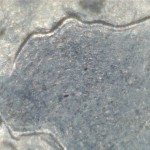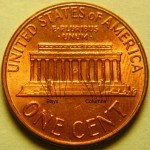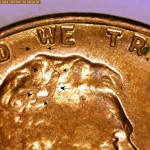A • B • C • D • E • F • G • H • I • J • K • L
M • N • O • P • Q-R • S • T • U • V • W • X-Z
Welcome to the Lincoln Cent Forum Glossary.
Use the alphabetical links above to navigate to the desired term.
This glossary of terms was written and compiled by Will Brooks with the help of our forum members. A huge thanks to everyone who contributed knowledge, ideas, words, and photos to make this growing educational resource possible. Special thanks to Richard Cooper, aka “Coop” who donated many of the photos.
Cameo: A proof coin that has mirror-like fields and frosted-looking devices. On earlier proof coinage, only the first coins struck from the die exhibit this appearance and are highly prized by collectors. Third party graders use designations of “cameo,” “deep cameo,” and “ultra-cameo” depending on the degree to which this shows on a coin.

Canceled Coin: A coin or planchet which is unacceptable by mint standards is put into a cancelling machine, which creates a corrugated pattern on the coin. These are then sent away for recycling.


Canceled Die: A die that is retired from use has its design elements abraded away, so it can no longer be used to strike coins. Images donated by Onecent1909.


Capped Die: See Die Cap.
Carbon Spots: Hard, black spots that are present due to poor Mint handling or wash residues from Mint processes. They are permanent and cannot be removed without damaging the coin surfaces. (Thanks to Thad Meszaras for this definition.)

Cartwheel Luster: See Mint Luster.
Cast Coin: A coin that is made by pouring molten metal into a mold. Most modern coinage is made by a die striking a planchet.
Cast Counterfeit: A fake coin made by pouring molten metal into a mold. Most modern coinage is made by dies striking a planchet. There are many U.S. Cents being counterfeited (especially by the Chinese) using this method. The cast is often made from hardened sand, and thus a cast coin often exhibits pitting, smooth rounded holes and raised bumps in the surface, and more rounded devices. Also, since these coins are not struck by a die, they will exhibit no die-flow lines. Cast coins are often polished to hide these imperfections. Below is a sand cast counterfeit of a 1943 “copper” cent. Images donated by liveandievarieties.



Cent: In the United States, 1/100th of a dollar. Commonly called a “penny.”
Certified: A coin that has been graded, and/or attributed as a certain variety or error, by a professional third party grading service. The coin is then “slabbed,” meaning it is put into a holder with its attributes labeled and recorded.
Channeling (Trenching): On many Lincoln cents from the 1920s to the 1950s, we see an incuse “channel” surrounding parts or all of Lincoln’s bust. It is believed that many working hubs had this channel engraved around the bust, possibly in an effort to prolong the life of the working hub, or to sharpen the profile, although we are not certain of the reason. Once believed to be a master die issue, it is now more commonly believed to have been done on individual working hubs, as it shows inconsistently on coins within a given year. 2nd Photo courtesy of 2Old.


Cherrypick: A slang term for identifying and buying a variety or error coin at the price of a normal coin.
Choice: A somewhat nebulous term often used to denote a higher-end grade within each grading standard. For example, a coin that grades XF45 might be considered “choice XF.” On uncirculated coins, “choice” (usually graded MS63/64) is considered below “gem,” and “superb.”
Circulation Wear: The process of a coin being handled and used. The everyday use and handling of coins causes minor damage to them in the form of hits, dents, scratches, etc., which we call “wear.”
Clad: (defined here to differentiate from plated coins) A clad coin is one which has differing layers of metal which are mechanically bonded to one another. This is in contrast to plated coins, which use electrolysis to bond a coating of one metal onto another. Most U.S. Coinage is clad, but Lincoln cents made from mid 1983 to the present are plated. There are no clad U.S. Cents.
CLAM: See Close AM.
Clash Marks ( Remnants): The visible marks on a coin, created by damage to the dies from them accidentally striking each other, rather than a planchet, thereby transferring part of each design onto the opposing die. See Die Clash.

Clashed Dies: See Die Clash.
Cleaned (improperly): A coin whose surfaces have been mechanically or chemically altered usually in an effort to make it appear in more original condition. A cleaned coin may show any number of undesirable qualities such as surface scratches, or discoloration, and will lack original mint luster and color. A coin that has been cleaned is invariably less desirable than one in its natural state.

Clip: See Clipped Planchet.
Clipped Planchet: An error created when the sheet metal from which blanks are cut is misfed resulting in an incomplete blank being cut. If the blank is cut from an overlapped section of a previously cut blank, it will result in a curved clip. If the blank is cut overlapping the edge of the sheet metal, it will result in a straight clip.

Close AM (CLAM) (RDV-007): This refers to the reverse design intended for use on business strike Lincoln cents for 1993 to 2008, and on proof cents in 1993. This variation had the A and M of AMERICA nearly touching each other at the bottom while previous variations featured a spaced-apart AM. There was also a change in the font of the initials, FG. Some 1992 cents were produced with this transitional design intended for use in the following year. These 1992 CLAM mini-mules are quite rare and worth a strong premium. Also, some 1998 and 1999 proof cents also were minted with this wrong design. Proofs in those years were supposed to have the Wide AM design. These also carry a very strong premium. Note: RDV-007 is a proprietary term of http://varietyvista.com/. Please see John Miller’s excellent tutorial Here.

CLV: See Initials.
Column: This refers to one of the columns of the memorial building on the reverse of memorial cents. The spaces between the columns are called bays. There are 12 columns and 11 bays.

Collar: The part of the striking apparatus that holds the planchet in place, and restricts its expansion, while the coin is struck.
Commemorative: A special coin or token minted to honor an important historical person, place or event. These coins are generally made for collectors and not for everyday circulation.
Concentric Lathe Marks (Lines): A misnomer used to describe the sections of a spiral line seen on a coin resulting from inadequate polishing of a die blank after it is lathed and before it is hubbed. It is actually one continuous spiral, and not truly concentric rings as the term suggests. See Lathe Line. A comprehensive listing of lathe lines can be seen and attributed at errorvariety.com.

Condition Census: A report of the finest known examples of any given issue.
CONECA: Combined Organization of Numismatic Error Collectors of America
Conservation: The treatment of a coin to preserve its condition. This is not considered “cleaning” and is an acceptable practice in numismatics. Please see Thad Meszaras’ tutorial on conservation Here.
Contact Mark : A hit or damage mark on a coin from any other object. Coins can sustain contact marks before they ever leave the mint from other coins they come into contact with during production, or bagging.
Copper: Abbreviated Cu, copper is an element used in the production of Lincoln cents. See Alloy
for a breakdown of the amount of copper used in various years for Lincoln cents.
Copy: A coin replicated to look like an actual mint issue. A “copy” is generally made without the intention to deceive and is for collecting purposes. These replicas should always have the word “copy” stamped on them, although it is sometimes omitted by those wishing to pass off counterfeits as real.
Corrosion: See Verdigris, See Acid Job.
Counter-clash: This is when already-clashed dies clash together a subsequent time, and the clashed design from the opposite die is re-imprinted back (in original orientation) on its die of origin in an off-set position. This is called a Type 1 counter-clash. A type 2 counter-clash occurs when a foreign piece of metal between the dies is struck with part of a die’s design and then a subsequent clash event transfers that design from the foreign object back onto one of the dies in a new position. There are currently 4 known type 2 counter-clashes in the Lincoln cent series. One on 1969S, two on 1983 cents, and one on a 1985 issue. In addition to the photos below, and comprehensive list of known type 1 and type 2 counter-clashes can be seen at maddieclashes.com.


Cracked Skull: This is simply a die crack or series of die cracks in the head region of the bust on a Lincoln cent. This is a very common area for die cracks to develop. Jean Cohen lists “cracked skulls” in her book on “Errors on the Lincoln Cent.” See also Spiked Head. Photos courtesy of jmangham and 2Old.


Counter-stamp: A coin that had a additional design intentionally punched into its surface after it was struck. There are many different examples of this found on Lincoln cents, including masonic symbols, cigars, the outline of U.S states, and many others. This is considered a form of post-strike damage, but many find these collectible.

Counterfeit: A replica made of something in an attempt to pass it off as the real thing, as opposed to a copy, which is a replica of something made without the intention to deceive. The counterfeiting of Lincoln cent varieties is rising sharply, especially by Chinese counterfeiters. See Cast Counterfeit and Struck Counterfeit.
Cud: A rim to rim die break, resulting in a piece of the die breaking off and falling out. The coins struck by such a die will exhibit a “blob” of raised metal along the rim where the normal design element should be. Cuds are always connected to the rim, else they are called interior die breaks. Due to the missing chunk in the die, the opposite side of the coin will exhibit a weakly struck area as shown in the 2nd photo below. Please visit cuds-on-coins.com for cud listings and attributions.



Cull: A very low grade coin with a lot of damage or corrosion or wear.
Curved Clip: See Clipped Planchet.
Customer Wrapped Roll: A roll of coins from the bank that was rolled and turned in by a bank customer. These are often prized by variety searchers above modern bank-wrapped rolls because of the possibility of rarer finds.